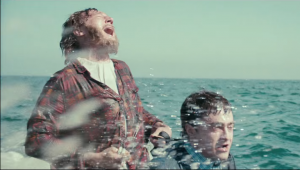It’s that time of year again: late mid-February, about six week after most professionals have published their Best of [insert year] lists and I finally get around to doing my annual music awards.
I spent a lot of time alone this year, because I became single and, for the first time in my life, moved into my own apartment, sans roommate. A bunch of stuff I liked, or was drawn to, drew me in because I was feeling lonely — or giddy with independence. Or it just had a good beat and I could dance to it.
This year, I’ve made a playlist on Spotify, so you can listen along to the full list of songs I loved last year, not just the winners of the weird categories I made up.
Most Excellence in Dadaism
It’s a tie!
Drake, “Hotline Bling.”[embedyt] http://www.youtube.com/watch?v=uxpDa-c-4Mc[/embedyt]
No one can deny that Drake’s mega hit is the year’s ear worm of doom, and it’s an awesome one, only partly because the video was instantly iconic in mixing high art light sculpture with hip hop tropes and a heavy dose of WTF dancing. But the lyrics and structure sound like e. e. cummings got dissed by a phone sex operator and then smoked a really huge bowl. Hilarious, awesome.
Weezer, “Thank God for Girls.”[embedyt] http://www.youtube.com/watch?v=DJMruBJfhNM[/embedyt]
I fell in love with Weezer 20 years ago, and have remained an apologist after they became uncool, because of the Blue Album‘s perfect blend of polished grunge and ironic, witty, and delightfully odd lyrics. (The videos were icing.) “Thank God for Girls” is as a batshit crazy as “Pork and Beans” and as catchy as “Beverly Hills.” It’s a underheard song, and delightful in its retro, childlike heterosexuality.
Most Excellence in Spine-Chilling Nostalgic Ennui
It’s a tie!
Jeffrey Foucault, “Des Moines.”[embedyt] http://www.youtube.com/watch?v=w46hwtgdJq8[/embedyt]
Jeffrey Foucault (pronounced incorrectly as Foh-calt) is a hotter, deeper, bluesier Bill Morrissey, and this could be his best song, a remembrance of a gig and a friendship in Iowa. When he sings at the crescendo, “We walked in like a rock and roll band,” I fell in love with the reflexive, probably revisionist, joy.
“Painting” from Fortress of Solitude.[embedyt] http://www.youtube.com/watch?v=cyheDip0hW8[/embedyt]
In order to transition several years of the 1970s in Fortress of Solitude, Abraham Ebdus (Ken Barnet) sings about all of the things that happened, major historical and emotional events, and how he ignored them while he painted. There’s subsumed anger and grief, and I wept in the theater the first time I heard it.
Most Excellence in Coincidence
Adam Lambert, “Ghost Town.”[embedyt] http://www.youtube.com/watch?v=Ix8ocFEMa1o[/embedyt]
Adam Lambert’s version came out first, and it’s gorgeous, weird, innovative, and I found it thrilling. I’m a huge Lambert fan and I feel I’m sometimes an apologist for his super poppy corporate stuff. But this is nothing anyone should apologize for. Unless you’re apologizing for not liking it.
Madonna, “Ghost Town.”[embedyt] http://www.youtube.com/watch?v=GgDxv0Qg_Rg[/embedyt]
Madonna’s isn’t as great, but it’s a good catchy ballad. True, it’s got that kind of guarded metaphor-as-emotion thing that a lot of her slow stuff suffers from, unlike “HeartBreakCity,” which is raw. But I was going through a terrible time when it came out, and it got under my skin. And Rebel Heart is easily her best album since Confessions on the Dance Floor or, less easily but arguably, since Music.
Most Excellence in Emotional Wreckage.
Adele, “Hello.”[embedyt] http://www.youtube.com/watch?v=YQHsXMglC9A[/embedyt]
Yeah. The day it was released, I had an uncontrollable urge to revisit every one of my previous relationships. Now that it’s become so embedded in the culture and parodied relentlessly, it has less power, but that weekend was tough.
Most Excellence in Barnstorming Pop.
Demi Lovato, “Cool for the Summer.”[embedyt] http://www.youtube.com/watch?v=il9nqWw9W3Y[/embedyt]
I love a good call for sexual adventure, even if it’s paint-by-nunbers corporate pop sung by a Disney vet. Because sometimes, it’s this damn thrilling.
Most Excellence in Singles: My Top 5 (or, rather, 6)
Kendrick Lamar, “King Kunta.”[embedyt] http://www.youtube.com/watch?v=hRK7PVJFbS8[/embedyt]
I must admit, I didn’t quite know for some time what this song was about other than swag and ego, and since Kendrick Lamar is lyricist of subtlety and depth I doubt that swag and ego is what it’s actually about. So, I Googled. Oh, it is about swag and ego, but the reference to Kunte Kinte to express empowerment, struggle, and growth makes it a bit subtler, and perhaps ironic, than, say, Kanye West’s “Power.” Also, King Kunta is funky as hell, with a rhythm, both in Lamar’s usual flow and in the bass line, that is irresistible as hell.
Alabama Shakes, “Gimme All Your Love.”[embedyt] http://www.youtube.com/watch?v=_sNNTpORtDQ[/embedyt]
This is an epic love song that actually sounds like being in love, that painful, hungry kind if love. It’s astonishing.
Shamir, “On the Regular” and “Make a Scene.”[embedyt] http://www.youtube.com/watch?v=Lp9GgdCgMXk[/embedyt]
[embedyt] http://www.youtube.com/watch?v=Zq4DumzwmlY[/embedyt]
Shamir’s was the best live show I saw in 2015, and not just because it was surprising that this 21-year-old super-gay rapper on a promo tour could control a room like he Springsteen. Okay, that was a lot of it. But the songs are thrilling, too, with the double whammy of these two singles. The lyrics are quite insightful for a teenager, but they’re also funny as hell. And gay. Gayyyy.
Courtney Barnett, “Elevator Operator.”[embedyt] http://www.youtube.com/watch?v=6sZxnyn6mRY[/embedyt]
This rollicking song is a short story about a young man named Oliver Paul who decides to play hooky from his job one morning. When he takes an elevator to the roof of a tall building with a rich old lady, she thinks he’s planning to commit suicide. Oh, no:
He said “I think you’re projecting the way that you’re feeling
I’m not suicidal, just idling insignificantly
I come up here for perception and clarity
I like to imagine I’m playing SimCity
All the people look like ants from up here
And the wind’s the only traffic you can hear
Courtney Barnett is some weird Aussie rock version of Raymond Carver.
Jamie xx, “Loud Places.”[embedyt] http://www.youtube.com/watch?v=TP9luRtEqjc[/embedyt]
This is singer-songwriter electronica at its best. It’s just perfectly beautiful, musically complex, and epic. A true work of art.
Most Excellence in Albums: My Top 5
Courtney Barnett, Sometimes I Sit and Think, and Sometimes I Just Sit.[embedyt] http://www.youtube.com/watch?v=o-nr1nNC3ds[/embedyt]
I already said it: Aussie rocker Raymond Carver. She’s the heir to Liz Phair, Bruce Springsteen, and, hell, Peter Carey. I love the hell out of this revelatory album.
Chris Stapleton, Traveller.[embedyt] http://www.youtube.com/watch?v=jqUx-WDL-Pc[/embedyt]
[embedyt] http://www.youtube.com/watch?v=FM_Xh5xPnmo[/embedyt]
Aside from being sex on a stick, Chris Stapleton itelegraphs authenticity, as if he’s the love child of Johnny Cash and, well, Jeffrey Foucault. Authenticity as marketing tool is sort of the definition of inauthentic (Bernie Sanders, cough) but sometimes it’s compelling. Especially when it sounds like a country-rock god singing about stuff that is not trucks, guns, hometowns, or beer.
Ryan Adams, 1989.[embedyt] http://www.youtube.com/watch?v=i65kX8cnswg[/embedyt]
[embedyt] http://www.youtube.com/watch?v=JSyus3HlQPI[/embedyt]
Taylor Swift’s 1989 is a damn fine pop album, but as reinterpreted by Ryan Adams, the songs develop a depth of emotion that her producers — Max Martin, et al. — made sure they couldn’t have, since depth of emotion doesn’t quite work on Top 40 stations, unless it’s Adele. His versions are so smart, gorgeous, and serious, I grew even more impressed by Swift’s lyrics. And then she did acoustic versions of the songs, and, well, she should do that more often.
Liane La Havas, Blood.[embedyt] http://www.youtube.com/watch?v=DNLkD8QEnAM[/embedyt]
[embedyt] http://www.youtube.com/watch?v=YFic-xaLsPs[/embedyt]
I loved Lianne’s first album, which is beautiful, if quiet. But Blood is not quiet at all; it’s sexy and fun and beautiful and it rocks and, hey, the President loves it, too. Every song is great. Period.
Carly Rae Jepson, Emotion.[embedyt] http://www.youtube.com/watch?v=TeccAtqd5K8[/embedyt]
[embedyt] http://www.youtube.com/watch?v=UlFMVzo9zuE[/embedyt]
This is my second favorite Taylor Swift album of the year, after Ryan Adams’s. Weirdly under-appreciated by radio, it’s an album of masterful pop songs that sit firmly in Swift’s genre but seem, somehow, better. Maybe it’s because Swift’s personality is so huge that she overshadows the music. Anyway, Jepson doesn’t have that celebrity profile, and the songs become more universal. It was album was the soundtrack of my summer. Fun as hell.


